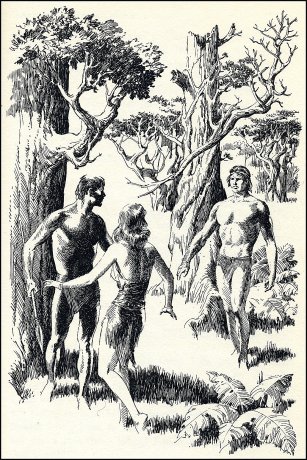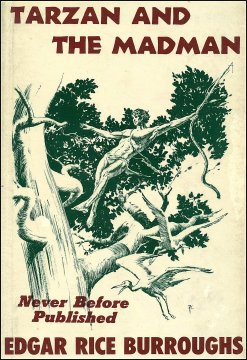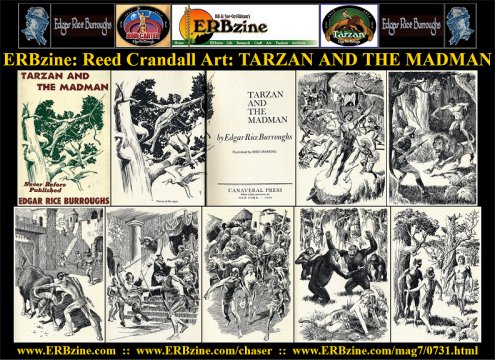What
A Long Strange Trip It's Been
In everyone's life there
comes a time to recapitulate. Tarzan And The Madman
was that time for Edgar Rice Burroughs. The Great Saga began in 1912
and in this novel of 1940 unpublished durng his lifetime the long strange
trip, to quote the Grateful Dead, came to an end. The Big Bwana and
his imposter got on a plane and flew out of Africa never to return.
Two more novels would follow
but they were placed in the Pacific either in or near Indonesia.
The succeeding
Tarzan And The Castaways was also unpublished
during his lifetime while
Tarzan And The Foreign Legion could
find no takers so was published by ERB, Inc. It almost seemed as
though the sun had gone down on the Great Ape Man.
Of course the movie Tarzan still
prospered, first with the great Johnny Weissmuller and then Lex Barker.
ERB even tips his hat to MGM by replicating the flight through the fog
to the great tabletop of the Mutia Escarpment, an MGM invention.
Thus, the last game is played out on the MGM playing field. Just
as ERB and Florence left LA on a plane so Rand and the Goddess and Tarzan
do Africa in this novel. In a short 157 pages ERB manages to recap
the Big Fella's entire career in print or on film.
In reading through the book this
last time I suddenly realized the significance of all those doppelgangers.
They signified the problem ERB was having realizing his ambition to be
the man who was Tarzan. In Madman he gives up the ghost realizing
his failure to become the Man-who-thought-he-was-Tarzan but wasnít.
Now typing away in exile from LA on Hawaii he throws in the towel.
As I have tried to show in my
other reviews, ERB read Robert Louis Stevenson's The Strange
Case Of Dr. Jekyll And Mr. Hyde probably sometime before 1890 within
a four years of its issue. The book must have been a sensation during
his years at the Michigan Military Academy, the subject of endless discussions
among the cadets. As hard as it must be for us to realize what we
consider a classic was an exciting new book for ERB. No movies could
be made of it because the technology hadn't been developed as yet.
Even the primitive Nickelodeons were shimmering a ways into the future.
Yea, verily, the future lay before them.
The novel was significant enough
to be in the first batch of talkies being first produced in 1931.
I'm sure ERB was transfixed as the story unfolded on the screen.
The theme of psychological doubles had dominated the Tarzan oeuvre from
the beginning. While it seems repetitious to a first reading of the
novels the theme is actually developing as the series progresses.
ERB didnít so much fall back on a cliche to him, but he was working out
a variation on the theme of Jekyll and Hyde.
He says that he was convinced
that every man had two sides to his personality, perhaps not as pronounced
as that of Jekyll and Hyde but there nonetheless. He was aware of
his own duality chronicling it in the pages of the Tarzan oeuvre.
The duality is often prompted by a blow to Tarzan's head. The blow
certainly commemorates the hit ERB took in Toronto while perhaps the aftermath
split ERB's personality so that he became two nearly different people.
Perhaps that's the secret of his writing career as he said that he was
able to disappear into the alternate reality when he wrote.
Tarzan always had two personalities
from the beginning. He was both a civilized man and a beast.
This undoubtedly represents ERB's feelings about himself. Perhaps
he had periods when he was something of a wild man, not unlike Tarzan on
the Rue Maule in The Return Of Tarzan, who became a beast
and then shook himself back into a human not unlike the transformation
of Jekyll and Hyde. This type of duality would characterize the Russian
Quartet, the first four novels.
The Tarzan doppelganger first
appeared in Jewels of Opar where, having received a blow
to the head, he loses his memory during which he lived as an uncivilized
beast, regaining civilization with his memory, but he had not yet split
into two co-existing separate identities. That
would first occur in Tarzan And The Golden Lion and Tarzan
And The Ant Men when the great character of Esteban Miranda
served as a doppelganger. Esteban was identical to Tarzan in appearance
but an arrant coward compared to Tarzan. This was a characteristic
of all the doubles. Esteban represented the negative pre-success
side of ERB while Tarzan the positive post-success side. Thus in
thse two novels ERB is beginning the attempt to become Tarzan -- The-Man-Who-Thought-He-Could-Be-Tarzan.
ERB was very sensitive about
his early failings in his relationship with Emma. In these two novels
he offered Jane/Emma the chance to recognize him as the strong Tarzan and
not the weakling Esteban doppelganger. Having overcome the failures
of his past he felt he had proven himself as a man and a supreme provider
demanding recognition. Given the decision to make Jane/Emma chose
ERBís former existence, Esteban, thereby sealing her fate. After
her ill-fated choice Jane disappears from the oeuvre except for the chance
encounter in the succeeding novel
Tarzan, Lord Of The Jungle
whereas the Golden Lion assumes a prominent role.
 While the next double, Stanley Obroski, appears in Tarzan And The
Lion Man, a double of sorts in the form of Lord Passmore makes
his appearance in Tarzan Triumphant. Another double
appears in Tarzan And The Leopard Men when, felled by a giant
tree in a storm, Tarzan blanks out assuming another persona.
Also, in Tarzan And The City Of Gold Valthor serves as a
double. In a strange variation ERB repeats the story of Jewels
Of Opar when Tarzan rescues Jane from the Arab boma. Here,
in an exact duplicate of that scene, he rescues Valthor. Thus Jane
and Valthor are connected in ERBís mind.
While the next double, Stanley Obroski, appears in Tarzan And The
Lion Man, a double of sorts in the form of Lord Passmore makes
his appearance in Tarzan Triumphant. Another double
appears in Tarzan And The Leopard Men when, felled by a giant
tree in a storm, Tarzan blanks out assuming another persona.
Also, in Tarzan And The City Of Gold Valthor serves as a
double. In a strange variation ERB repeats the story of Jewels
Of Opar when Tarzan rescues Jane from the Arab boma. Here,
in an exact duplicate of that scene, he rescues Valthor. Thus Jane
and Valthor are connected in ERBís mind.
In Tarzan And The Lion
Man Burroughs kills off his weaker persona thus assuming the role
of Tarzan himself. Then in Tarzan And The Forbidden City
Brian is his look-a-like, although the role of double is not explored.
Perhaps this is the initial realization the ERB has failed in his quest
to be Tarzan.
After a decade of trials and
tribulations struggling against the Communists and MGM and losing, ERB
sat down in exile at the beginning of 1940 to write this confession of
defeat.
The man-god Tarzan himself remains
the same but The-Man-Who-Thought-He-Was-Tarzan but failed confesses his
defeat, getting into his airplane up there on MGMís Mutia Escarpment flying
out of Africa forever. First he was expelled from Opar by the Communists
and then from Africa by MGM.
Although Tarzan was in the plane
with him, the Big Bwana shows up again in Africa for a moment in Tarzan
And The Castaways. This novel written in a style entirely
different from the rest of the oeuvre was also unpublished during Burroughs
lifetime, hidden away in a safe.
In this novel Tarzan is defeated
by a Black chief, symbolically perhaps, captured and sold as a wild man,
a feral child. Once again Tarzan has lost his memory reverting to
a pure beast or feral boy. As this novel was written after King
Kong and Tarzan ends up on yet another island, perhaps ERB was
conflating the movie with this novel. Tarzan is put aboard
ship with the other animals destined for the circus and taken from the
continent.
Running all through Burroughs
is the ghost of Jule Verne's Mysterious Island. Once
aboard ship a storm assaults the ship which, signficantly loses its rudder.
Thus, like the now rudderless Burroughs, the ship is adrift. In a
scene reminiscent of both Verne's novel and Robert Louis Stevenson's Kidnapped
the ship is tossed atop a reef while all aboard including a Noahís Ark
of animals find their way to shore as the Castaways.
Stevenson and Verne were two
of ERB's earliest influences thus ERB returns full circle to his origins.
In the last Tarzan novel and
the last published in his lifetime, Tarzan And The Foreign Legion,
at the very end the fugitives from the Japanese army approach the remains
of the Mysterious Island that after the volcanic explosition of Verne is
a mere spire of rock in the vast ocean. Not a refuge in the world
left for Tarzan or ERB. Like Capt. Nemo a submarine surfaces to rescue
Tarzan and the Legion from a watery fate.
It seems amazing that as an honorary
Frenchman Tarzan was never placed in a situation with the real French Foreign
Legion. Perhaps P.C. Wren had preempted the genre with his magnificent
FFL trilogy which left no room for ERB's imagination to operate.
The long odyssey had ended.
ERB could not imitate his man-god, but he left him to us as an avatar for
the coming New Age. What a long strange trip it was and for us, will
be.




